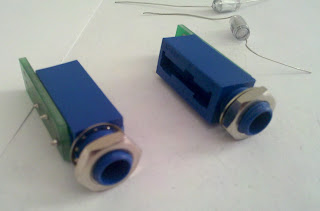While I'm debugging the VC Trigger Generator, and waiting for my MTA headers to arrive, I've been getting things together for my power supply panel.
I used David's power panel as a starting point - and am using the same power supply and switch/fuse unit, so those elements I could copy over. The one I'm making is using a MOTM-960 power distribution board, and is a full 3U rack panel, rather than a subrack panel. I've also added 3 jacks for a ground connection, so I can connect power supplies, or even use them for applying an S-Trigger signals.
I printed out the panel just to make sure everything seemed to fit. Seems good, so I've ordered the panel (plus panels for a VCA, a VCF, and two VCOs) today.
The power supply I'm using is the HAA15-0.8-AG. I'm somewhat second-guessing myself, if I shouldn't have used the HBB15-1.5-AG, to get 1.5 amps on each rail, rather than only 0.8 amps. But, the Synthasystem isn't too power intensive, and I'll probably end up with a couple anyhow. Of course, I could run the supply at +/-12V (and adjust the modules for that) to get 1.0 amps, but +/-15V is much more practical for me, as everything else I have (or am even considering building) runs at +/-15V.
More details when the panel comes in and I start putting this together! The power supply setup was the thing that scared/confused me the most when I was getting started in modular synths, so fingers crossed that this all comes together fine.
I used David's power panel as a starting point - and am using the same power supply and switch/fuse unit, so those elements I could copy over. The one I'm making is using a MOTM-960 power distribution board, and is a full 3U rack panel, rather than a subrack panel. I've also added 3 jacks for a ground connection, so I can connect power supplies, or even use them for applying an S-Trigger signals.
I printed out the panel just to make sure everything seemed to fit. Seems good, so I've ordered the panel (plus panels for a VCA, a VCF, and two VCOs) today.
The power supply I'm using is the HAA15-0.8-AG. I'm somewhat second-guessing myself, if I shouldn't have used the HBB15-1.5-AG, to get 1.5 amps on each rail, rather than only 0.8 amps. But, the Synthasystem isn't too power intensive, and I'll probably end up with a couple anyhow. Of course, I could run the supply at +/-12V (and adjust the modules for that) to get 1.0 amps, but +/-15V is much more practical for me, as everything else I have (or am even considering building) runs at +/-15V.
More details when the panel comes in and I start putting this together! The power supply setup was the thing that scared/confused me the most when I was getting started in modular synths, so fingers crossed that this all comes together fine.





















